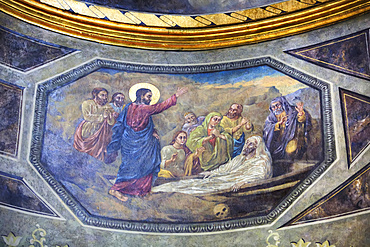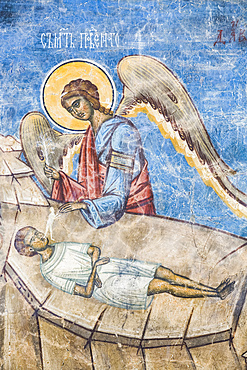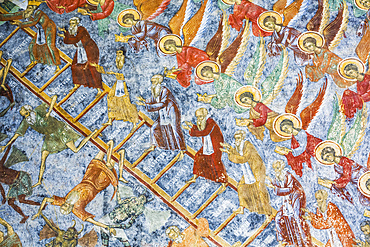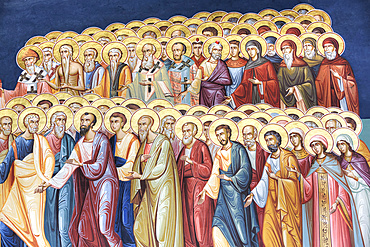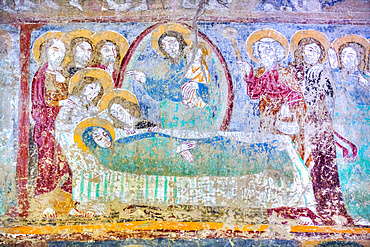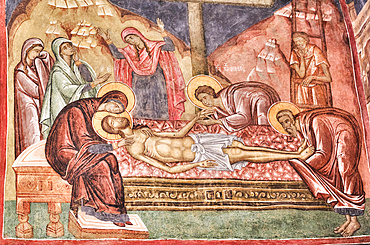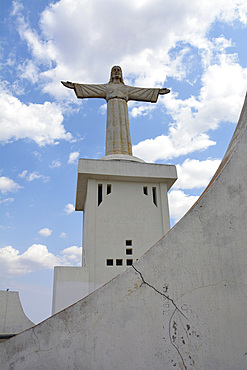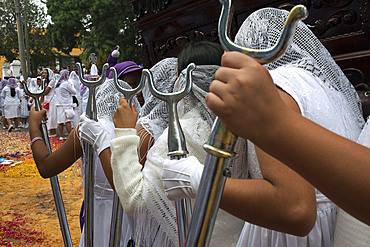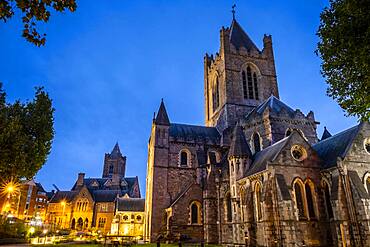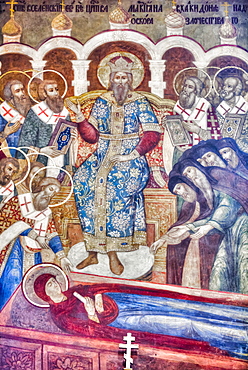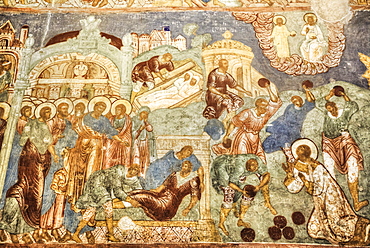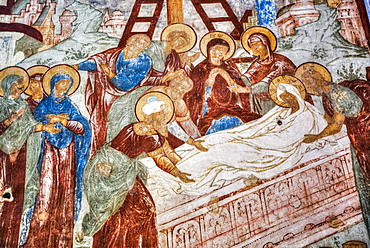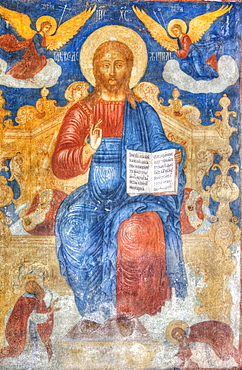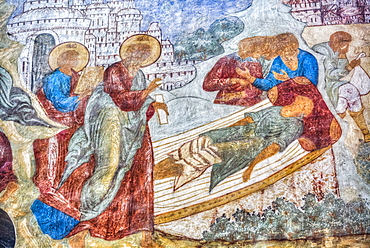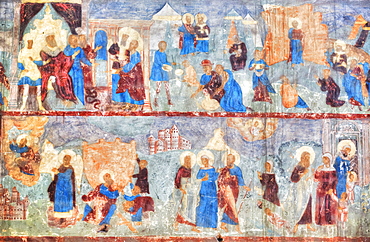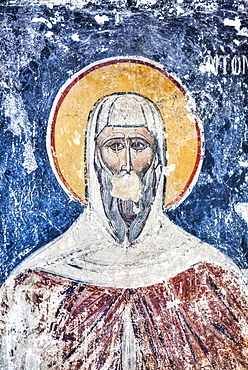Recent searches
Loading...
1116-51862 - Exterior frescoes, 'Last Judgement', Voronet Monastery, 1487; Gura Humorului, Suceava County, Romania
1116-51838 - Moldovita Monastery, 1532; Vatra Moldovitei, Suceava County, Romania
1116-51778 - Fresco, Church of St Anthony, reconstructed in 1673, Old Town Bucharest; Bucharest, Romania
1116-51776 - Frescoes, New St George Church, 1705, Old Town Bucharest; Bucharest, Romania
1116-51876 - Frescoes, Holy Trinity Cathedral, founded in 1902; Sibiu, Transylvania Region, Romania
1116-51779 - Fresco, Malancrav Fortified Church, 14th Century, Malancrav, Sibiu County, Romania
1116-51860 - Exterior frescoes, portion of 'Last Judgement', Voronet Monastery, 1487; Gura Humorului, Suceava County, Romania
1116-51875 - Frescoes, Holy Trinity Cathedral, founded in 1902; Sibiu, Transylvania Region, Romania
1116-51840 - External Fresco, 'Stairway of Virtue', Sucevita Monastery, 1585; Sucevita, Suceava County, Romania
1116-51844 - Interior Fresco, St George Church Mirauti, 1375; Suceava, Suceava County, Romania
1116-52250 - A colourful stained glass window in a circle-shape with intricate designs and symbols on a stone wall; Nelson, Nelson Province, New Zealand
1116-51870 - Fresco, Holy Trinity Cathedral, founded in 1902; Sibiu, Transylvania Region, Romania
1116-51874 - Fresco, Holy Trinity Cathedral, founded in 1902; Sibiu, Transylvania Region, Romania
1116-51775 - Frescoes, New St George Church, 1705, Old Town Bucharest; Bucharest, Romania
1116-51859 - Fresco of Mitropoli, Voronet Monastery, 1487; Gura Humorului, Suceava County, Romania
1116-51773 - Frescoes, New St George Church, 1705, Old Town Bucharest; Bucharest, Romania
1116-51849 - Interior fresco, Church of the Holy Cross, 1487; Patrauti, Suceava County, Romania
1116-51839 - External Fresco, Sucevita Monastery, 1585; Sucevita, Suceava County, Romania
1116-51780 - Fresco, Malancrav Fortified Church, 14th Century, Malancrav, Sibiu County, Romania
1116-51777 - Frescoes, New St George Church, 1705, Old Town Bucharest; Bucharest, Romania
1116-51841 - Interior Fresco, St George Church Mirauti, 1375; Suceava, Suceava County, Romania
1116-51843 - Interior Fresco, St George Church Mirauti, 1375; Suceava, Suceava County, Romania
1116-51861 - Exterior frescoes, portion of 'Last Judgement', Voronet Monastery, 1487; Gura Humorului, Suceava County, Romania
1116-51848 - Interior fresco, Church of the Holy Cross, 1487; Patrauti, Suceava County, Romania
1113-106836 - Angola; Huila Province; Lubango; Lookout point on the outskirts with the monumental statue of Christo Rei
1113-105608 - View over Danube to old town with Christ Church, Neuburg an der Donau, District of Neuburg-Schrobenhausen, Bavaria, Germany
1113-106663 - Wayside cross in Graswang near Ettal, Upper Bavaria, Allgäu, Bavaria, Germany
832-393327 - Diver looking at statue of Christ, Mediterranean Sea, San Fruttuoso, Portofino Peninsula, Liguria, Italy, Europe
1339-87 - Fancy woodwork holds Jesus Christ on the Cross inside the Fantoft Stave church, Bergen, Norway, Scandinavia, Europe
809-8293 - Statue of Jesus Christ crucified on a cross by Catherine Green, Basilica of the Holy Trinity, Fatima, Centro, Portugal, Europe
1350-2688 - Verges, a small town in the Northeast of Catalonia (Spain), during Easter celebrates the Procession of Verges with skeletons dancing on the sound of a drum, Roman soldiers, known as the 'Manages', and a representation of the life and crucifixion of Jesus Christ. The Procession features the Dance of Death, a tradition from the Middle Age associated with epidemics and plagues and the only one remaining in Spain Ten skeletons dance to the beat of a drum to remember that no one is exempt of death. The backdrop of the medieval walls and towers of Verges is key to this macabre staging.
1350-2856 - A man sits near a collection of Christian artwork within the church of Bet Medhane Alem (Church of the World Savior) in Lalibela, Ethiopia
1350-2865 - A painting of Mary and Jesus inside the rock hewn monolithic church of Bet Medhane Alem (Church of the World Savior) in Lalibela, Ethiopia
1350-2693 - Verges, a small town in the Northeast of Catalonia (Spain), during Easter celebrates the Procession of Verges with skeletons dancing on the sound of a drum, Roman soldiers, known as the 'Manages', and a representation of the life and crucifixion of Jesus Christ. The Procession features the Dance of Death, a tradition from the Middle Age associated with epidemics and plagues and the only one remaining in Spain Ten skeletons dance to the beat of a drum to remember that no one is exempt of death. The backdrop of the medieval walls and towers of Verges is key to this macabre staging.
1350-2692 - Verges, a small town in the Northeast of Catalonia (Spain), during Easter celebrates the Procession of Verges with skeletons dancing on the sound of a drum, Roman soldiers, known as the 'Manages', and a representation of the life and crucifixion of Jesus Christ. The Procession features the Dance of Death, a tradition from the Middle Age associated with epidemics and plagues and the only one remaining in Spain Ten skeletons dance to the beat of a drum to remember that no one is exempt of death. The backdrop of the medieval walls and towers of Verges is key to this macabre staging.
1350-2695 - Verges, a small town in the Northeast of Catalonia (Spain), during Easter celebrates the Procession of Verges with skeletons dancing on the sound of a drum, Roman soldiers, known as the 'Manages', and a representation of the life and crucifixion of Jesus Christ. The Procession features the Dance of Death, a tradition from the Middle Age associated with epidemics and plagues and the only one remaining in Spain Ten skeletons dance to the beat of a drum to remember that no one is exempt of death. The backdrop of the medieval walls and towers of Verges is key to this macabre staging.
1350-3751 - Holy Week processions in Guatemala city. Holy Thursday. Holy Week in Guatemala is celebrated with street expressions of faith, called processions, usually organized by a "hermandades". Each procession of Holy Week has processional floats and steps, which are often religious images of the Passion of Christ, or Marian images, although there are exceptions, like the allegorical steps of saints.
1350-2857 - A woman sits in front of a painting of jesus Christ inside the church of Bet Medhane Alem (Church of the World Savior) in Lalibela, Ethiopia
1350-2690 - Verges, a small town in the Northeast of Catalonia (Spain), during Easter celebrates the Procession of Verges with skeletons dancing on the sound of a drum, Roman soldiers, known as the 'Manages', and a representation of the life and crucifixion of Jesus Christ. The Procession features the Dance of Death, a tradition from the Middle Age associated with epidemics and plagues and the only one remaining in Spain Ten skeletons dance to the beat of a drum to remember that no one is exempt of death. The backdrop of the medieval walls and towers of Verges is key to this macabre staging.
1350-3753 - Holy Week processions in Guatemala city. Holy Thursday. Comparsa. Holy Week in Guatemala is celebrated with street expressions of faith, called processions, usually organized by a "hermandades". Each procession of Holy Week has processional floats and steps, which are often religious images of the Passion of Christ, or Marian images, although there are exceptions, like the allegorical steps of saints.
1350-2691 - Verges, a small town in the Northeast of Catalonia (Spain), during Easter celebrates the Procession of Verges with skeletons dancing on the sound of a drum, Roman soldiers, known as the 'Manages', and a representation of the life and crucifixion of Jesus Christ. The Procession features the Dance of Death, a tradition from the Middle Age associated with epidemics and plagues and the only one remaining in Spain Ten skeletons dance to the beat of a drum to remember that no one is exempt of death. The backdrop of the medieval walls and towers of Verges is key to this macabre staging.
1350-2687 - Verges, a small town in the Northeast of Catalonia (Spain), during Easter celebrates the Procession of Verges with skeletons dancing on the sound of a drum, Roman soldiers, known as the 'Manages', and a representation of the life and crucifixion of Jesus Christ. The Procession features the Dance of Death, a tradition from the Middle Age associated with epidemics and plagues and the only one remaining in Spain Ten skeletons dance to the beat of a drum to remember that no one is exempt of death. The backdrop of the medieval walls and towers of Verges is key to this macabre staging.
1350-2689 - Verges, a small town in the Northeast of Catalonia (Spain), during Easter celebrates the Procession of Verges with skeletons dancing on the sound of a drum, Roman soldiers, known as the 'Manages', and a representation of the life and crucifixion of Jesus Christ. The Procession features the Dance of Death, a tradition from the Middle Age associated with epidemics and plagues and the only one remaining in Spain Ten skeletons dance to the beat of a drum to remember that no one is exempt of death. The backdrop of the medieval walls and towers of Verges is key to this macabre staging.
1350-2696 - Verges, a small town in the Northeast of Catalonia (Spain), during Easter celebrates the Procession of Verges with skeletons dancing on the sound of a drum, Roman soldiers, known as the 'Manages', and a representation of the life and crucifixion of Jesus Christ. The Procession features the Dance of Death, a tradition from the Middle Age associated with epidemics and plagues and the only one remaining in Spain Ten skeletons dance to the beat of a drum to remember that no one is exempt of death. The backdrop of the medieval walls and towers of Verges is key to this macabre staging.
1350-2697 - Verges, a small town in the Northeast of Catalonia (Spain), during Easter celebrates the Procession of Verges with skeletons dancing on the sound of a drum, Roman soldiers, known as the 'Manages', and a representation of the life and crucifixion of Jesus Christ. The Procession features the Dance of Death, a tradition from the Middle Age associated with epidemics and plagues and the only one remaining in Spain Ten skeletons dance to the beat of a drum to remember that no one is exempt of death. The backdrop of the medieval walls and towers of Verges is key to this macabre staging.
1350-2694 - Verges, a small town in the Northeast of Catalonia (Spain), during Easter celebrates the Procession of Verges with skeletons dancing on the sound of a drum, Roman soldiers, known as the 'Manages', and a representation of the life and crucifixion of Jesus Christ. The Procession features the Dance of Death, a tradition from the Middle Age associated with epidemics and plagues and the only one remaining in Spain Ten skeletons dance to the beat of a drum to remember that no one is exempt of death. The backdrop of the medieval walls and towers of Verges is key to this macabre staging.
785-214 - Detail of Metropolitan Cathedral of Christ the King, Liverpool, Merseyside, England, United Kingdom, Europe
749-819 - The Metropolitan Cathedral of Christ The King, Liverpool, Merseyside, England, United Kingdom, Europe
1113-105356 - Jesus Christ played by a priest carrying the Cross, The Mystery of the passion of Christ Kalwaria Zebrzydowska, Cracow, Poland
1350-847 - Torists, Largest statue of Jesus Christ in the world, the Cristo de la Concordia in Cochabamba, Bolivia
1350-849 - View from the Cristo de la Concordia, Cochabamba, Bolivia
1350-848 - Torists, Largest statue of Jesus Christ in the world, the Cristo de la Concordia in Cochabamba, Bolivia
1350-1007 - Christ Church Cathedral, Dublin, Ireland
1116-49984 - Fresco, Holy Formation Cathedral, Trinity Sergius Lavra Monastery complex; Sergiev Posad, Moscow Oblast, Russia
1116-50023 - Fresco in the Church of St John the Baptist; Yaroslavl, Yaroslavl Oblast, Russia
1116-50173 - Frescoes, St Johns Forerunners Parish; Athens, Greece
1116-49989 - Fresco, Holy Formation Cathedral, Trinity Sergius Lavra Monastery complex; Sergiev Posad, Moscow Oblast, Russia
1116-50166 - Fresco, Transfiguration Cathedral, Monastery of St Euthymius; Suzdal, Vladimir Oblast, Russia
1116-50157 - Fresco, Miracle-Image of the Saviour Church, Kremlin, Golden Ring; Rostov Veliky, Yaroslavl Oblast, Russia
1116-50018 - Church of Elijah the Prophet, fresco on the wall of Elijah's ascension into heaven in a whirlwind; Yaroslavl, Yaroslavl Oblast, Russia
1116-50185 - Fresco, The Resurrection Church on the Debra; Kostroma, Kostroma Oblast, Russia
1116-50130 - Cathedral Of Christ the Saviour; Moscow, Russia
1116-50158 - Fresco, Miracle-Image of the Saviour Church, Kremlin, Golden Ring; Rostov Veliky, Yaroslavl Oblast, Russia
1116-50017 - Church of Elijah the Prophet, with colourful frescos on the wall depicting Biblical scenes of harvest; Yaroslavl, Yaroslavl Oblast, Russia
1116-50013 - Church of Elijah the Prophet, with colourful frescoes on the walls depicting Biblical scenes; Yaroslavl, Yaroslavl Oblast, Russia
1116-50164 - Fresco, Gate-Church of the Resurrection (1670), Kremlin, Golden Ring; Rostov Veliky, Yaroslavl Oblast, Russia
1116-50114 - Fresco, Holy Monastery of Varlaam, Meteora; Thessaly, Greece
1116-50148 - Interior Frescoes, Uspenskaya Church; Suzdal, Vladimir Oblast, Russia
1116-50186 - Fresco, Troitse-Sergiyev Varnitskiy Monastery, near Rostov Veliky, Golden Ring; Yaroslavl Oblast, Russia
1116-50168 - Interior Fresco, Cathedral of the Nativity (1222), Kremlin; Suzdal, Vladimir Oblast, Russia
1116-49998 - Fresco, Church of Elijah the Prophet; Yaroslavl, Yaroslavl Oblast, Russia
1116-50026 - Fresco in the Church of St John the Baptist; Yaroslavl, Yaroslavl Oblast, Russia
1116-50025 - Fresco in the Church of St John the Baptist; Yaroslavl, Yaroslavl Oblast, Russia
1116-50174 - Frescoes, St Johns Forerunners Parish; Athens, Greece
1116-50161 - Fresco, Gate Church of the Resurrection (1670), Kremlin, Golden Ring; Rostov Veliky, Yaroslavl Oblast, Russia
1116-50027 - Fresco in the Church of St John the Baptist; Yaroslavl, Yaroslavl Oblast, Russia
1116-50184 - Fresco, The Resurrection Church on the Debra; Kostroma, Kostroma Oblast, Russia
1116-50163 - Fresco, Gate-Church of the Resurrection (1670), Kremlin, Golden Ring; Rostov Veliky, Yaroslavl Oblast, Russia
1116-49988 - Frescoes, Holy Dormition Cathedral, Trinity Sergius Lavra Monastery complex; Sergiev Posad, Moscow Oblast, Russia
1116-50022 - Fresco in the Church of St John the Baptist; Yaroslavl, Yaroslavl Oblast, Russia
1116-50171 - Original Fresco, St Demetrius Cathedral (1194-97); Vladimir, Russia
1116-50021 - Fresco in the Church of St John the Baptist; Yaroslavl, Yaroslavl Oblast, Russia
1116-50172 - Frescoes, St Johns Forerunners Parish; Athens, Greece
1116-50167 - Fresco, Transfiguration Cathedral, Monastery of St Euthymius; Suzdal, Vladimir Oblast, Russia
1116-50019 - Church of Elijah the Prophet, with ornate arched doorways and colourful frescoes; Yaroslavl, Yaroslavl Oblast, Russia
1116-50010 - Fresco, New Testament Trinity, Spassky Monastery; Yaroslavl, Yaroslavl Oblast, Russia
1116-50004 - St John the Baptist Church, Trinity Lavra of St. Sergius; Sergiev Posad, Moscow Oblast, Russia
1116-50159 - Fresco, Gate-Church of St John, Kremlin, Golden Ring; Rostov Veliky, Yaroslavl Oblast, Russia
1116-49996 - Fresco, Church of Elijah the Prophet; Yaroslavl, Yaroslavl Oblast, Russia
1116-49985 - Fresco, Holy Formation Cathedral, Trinity Sergius Lavra Monastery complex; Sergiev Posad, Moscow Oblast, Russia
1116-49987 - Fresco, Holy Formation Cathedral, Trinity Sergius Lavra Monastery complex; Sergiev Posad, Moscow Oblast, Russia
1116-50005 - Fresco, St Michael the Archangel Church; Yaroslavl, Yaroslavl Oblast, Russia
1116-50020 - Church of Elijah the Prophet, with ornate arched doorway and colourful frescoes; Yaroslavl, Yaroslavl Oblast, Russia
1116-50131 - Fresco, St Johns Forerunners Parish; Athens, Greece
1116-50015 - Church of Elijah the Prophet, with colourful frescoes on the walls depicting Biblical scenes; Yaroslavl, Yaroslavl Oblast, Russia
1116-49997 - Fresco, Church of Elijah the Prophet; Yaroslavl, Yaroslavl Oblast, Russia
1116-49990 - Frescoes, Holy Dormition Cathedral, Trinity Sergius Lavra Monastery complex; Sergiev Posad, Moscow Oblast, Russia
1116-50156 - Fresco, Miracle-Image of the Saviour Church, Kremlin, Golden Ring; Rostov Veliky, Yaroslavl Oblast, Russia
1116-50132 - Original Fresco, 17th Century, Church of the Holy Apostles, 10th Century, Ancient Agora; Athens, Greece
1116-50155 - Fresco, Miracle-Image of the Saviour Church, Kremlin, Golden Ring; Rostov Veliky, Yaroslavl Oblast, Russia


